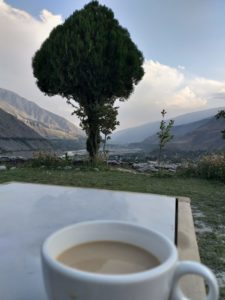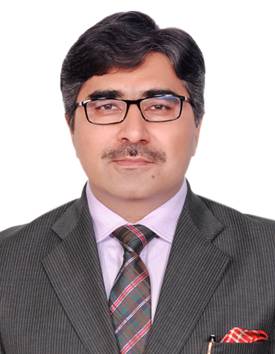
Damascus is in ruins, the idiomatic is thriving especially after the construction of Lowari tunnel. Prince Siraj Ul Mulk was on a wait since 8:30 pm. I entered lately into the lobby of his Hindukush Heights, when dinner time was over but not his welcoming eagerness. He stood up firmly, with his graceful Pakol over his head, shook my hand and referred my position, not distant to his. His overbearing Rhodesian Ridgeback, Polando, looked fresh, stout, and watchful as if on duty. He was on duty actually. He moved around the large sofa twice and then settled behind the prince. “It was a puppy, nine and half years ago. I brought it from Karachi. He is actually from South Africa and does not allow anybody behind me except himself,” the prince explained voluntarily to appease my apparent curiosity or seeming discomfort.
Earlier, I was served a cocktail made out of local apples and apricots. I also found out about the curious case of Polando. For more curious readers, there is no resemblance between Muhammad Hanif’s magnum opus The Case of Exploding Mangoes and the portrait of Polando.
I had interest in the story where Polando assumed a secondary position, his country of origin having the first one. South Africa was the country of my first international travel. My interest into the caricature of Polando was more than required. I asked about any relevance between Poland and Polando.
“I only added o with Poland, fixation stops here,” the prince replied with brevity, wit remaining discernible on his chiseled face. It was my first visit in this region, my inquisitiveness remained intact but contorted. For two more days I had yet to explore more. Prying contours morphed into magic when the journey was over.
After a few days, the prince received a call from a common friend from Islamabad. “He has approved Lowari tunnel. You will see it to happen soon,” the caller, a common friend of president Musharraf was so declarative and confident, The prince continued, “I rekindled my dwindling hope. Tunnel took time but I saw its execution despite the usual objections from the spectators mostly based in Islamabad. In Islamabad you see doubting Thomas in galore.” The prince was sharing the agony generations suffered in the past; before the tunnel, they had to travel for seven hours into Afghanistan en route to Torkham and then four more hours to reach Islamabad. Lowari tunnel has given an enduring memory to president Musharraf.
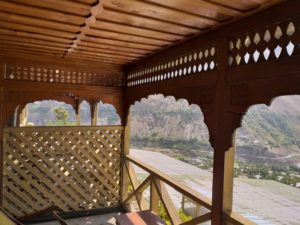
Chitral has two resemblances with Chile. Apart from the first three alphabets, both constitute two long and narrow strips on the maps of the Pakistan and on the map of world respectively. Chitral is a valley overlooked by the peaks of Tirich Mir, which, with the height of 25289 ft is the highest peak of the Hindukush range. Roaring Chitral river (also called Kunar river) gushes through thick and thin river beds and finally mixes its wrath with the Indus river near Attock. The several bends of the river go unnoticed, contrasting to VS Naipaul’s magisterial A Bend in the River.
The total population of the district Chitral is more than 4.5 million with an enviable 78% literacy rate. Chitral shares borders with Kunar, Badakshan and Nuristan provinces of Afghanistan to north and west and only a narrow strip of Wakhan Corridor disconnects Chitral from Tajikistan in the north.
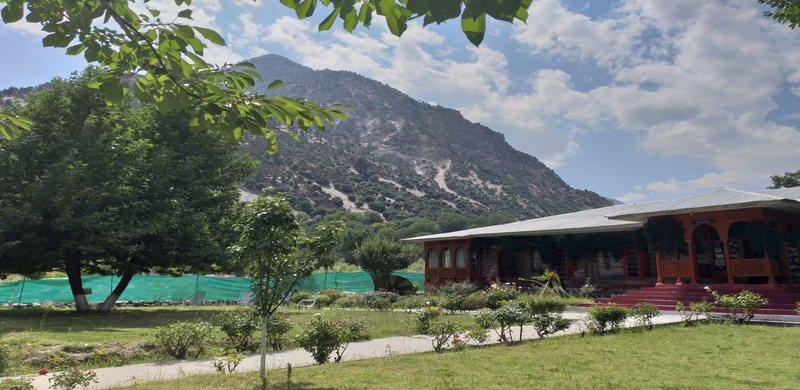
The people belong to over a dozen different cultures and speak some 14 languages. As a result of its distinctive location and historical links with Central Asia and Europe, the material and non-material culture of Chitral bears traces of Greeks, Iranians, Mongolian, Tatar and Turk influences. It remained an independent state for centuries with its own culture and language. In the late nineteenth century, it became part of British India. Prince Siraj’s grand uncle, His Highness Muzaffar Ul Mulk, signed its accession with Pakistan but ensured a blanket tax emption.
Chitral remained a princely state till 1969. President Yahya Khan integrated it with Pakistan along with the states of Dir and Swat. Today’s Malakand division is alien to taxation. “It’s a Panama, why mainland Pakistanis do not park their assets here?” joked Prince Siraj on the site of his under-construction bus terminal. At the terminal, Polando appeared perplexingly vigilant about the safety of his master. Crowd cautions Polando.
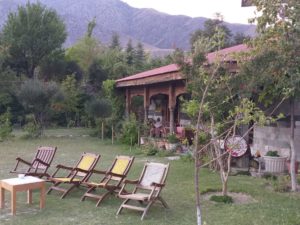
A famous product of Chitral is the pure wool fabric, woven from wholly hand-spun yarn. It forms into natural shades of white, gray, black and brown, and the unique walnut-dyed, the red one.
Chitral is incomplete without Shandur. Shandur is the highest polo ground in the world, the game of polo is played between Chitral and Gilgit annually in the month of July. Shandur is a six-hour journey from Chitral. Besides polo, Shandur’s celebrations have much to offer to the tourists, who throng the site almost a week before the three-day festivities.
Tourists usually spend the nights playing cards and dancing on local tunes. Music competitions are also held between groups representing Chitral and Gilgit. Famous Attan (folk dance popular among southern Pashtuns of KPK) can assume its magic if LD Khan collects few pilgrim souls from the tourists. On Attan, LD Khan has same irrefutably imposing importance as Ustad Bismillah Khan of Banaras once commanded on the playing of flute. Pundit Nehru enjoyed Ustad’s musicality, we in Pakistan adore LD’s rhythmic amusement during the unending ecstasy of Attan.
Charged under the influence of Mustansar Hussain Tarar’s captivating writings on Kalash, the young travelers were excited until the tour gave them inside assessments of the culture and of the supplementary myths. As a local, Wazir Muhammad was waiting as a guide at the gate of PTDC motel. He led us for three hours through the narrow streets of the Kalash villages. Kalash (Kafirs) now comprise of 4200 people according to Wazir, and are attractive and peace-loving people mainly live in three villages of Rukmu, Mumret and Biriu. The general population is Kho people, who speak the Khowar language.
Close to the graveyard, a boy of seven to eight years was squatted on a grassy ground, and was doing his school homework. I paused and I asked what do you want to be after the completion of your studies. With his unmuttering shyness he responded, “I will join the Pakistan army.” I did not ask the reason and wished him a smooth homework and uninterrupted studies.
Chitral’s commercial bazars are fairly broad but amazingly clean, free from usual garbage and encroachment. People are warm, self-satisfied, very honest and hardworking. Muhammad Nek was not willing to give me discounts on a woolen shall and on Pakol. “Sir, we do not quote exaggerated prices,” Nek explained with politeness. I diverted the discussion to his antique metallic cashbox ‘gala’. “It is 62 years old and my father had purchased it from Peshawar,” he informed me. I told him in German it is called Kasse. He murmured Kasse thrice. His fellow looked amused. Without my persistence, now, he made me a good discount.
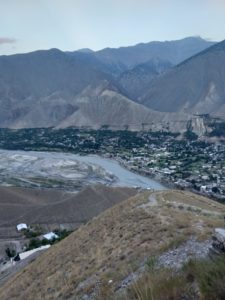
Centuries old walnut tall trees inside the fort are the custodians of Chitral’s warring history with the neighbouring states of Afghanistan. Natives have said farewell to arms long ago but not before the creation of Ernest Hemingway’s broadly thematic (iceberg theory) novel.
It was early in the morning and I had done my breakfast amid the poignant shrubs of lavender in the backyard of the Hindukush Heights. I was about to leave Chitral for Islamabad. The fragrance was more than a treat. Lavender’s scent cures migraines. Polando followed the prince who came to see me off. Tail twitching, Polando offered merry-go-rounds, this time I could not count. Polando, if were a reader of American literature, he must have been enamoured of James Thurber’s Snapshot Of A Dog. In the meanwhile, I asked prince about his take on Oscar Wilde’s Happy Prince. “Yes, I read it in my childhood but I do not dwell in the shadows of a tall wall. I just live with my people and that makes me happy,” he answered. Lavender shrubs were not moving, only the surreptitious fragrance was making inroads into my heart. Receptors of my mind were the first beneficiaries. My heart had no escape. Gateways? None!
Earlier, I was served a cocktail made out of local apples and apricots. I also found out about the curious case of Polando. For more curious readers, there is no resemblance between Muhammad Hanif’s magnum opus The Case of Exploding Mangoes and the portrait of Polando.
I had interest in the story where Polando assumed a secondary position, his country of origin having the first one. South Africa was the country of my first international travel. My interest into the caricature of Polando was more than required. I asked about any relevance between Poland and Polando.
“I only added o with Poland, fixation stops here,” the prince replied with brevity, wit remaining discernible on his chiseled face. It was my first visit in this region, my inquisitiveness remained intact but contorted. For two more days I had yet to explore more. Prying contours morphed into magic when the journey was over.
We walked in the adjoining, spacious dining hall. Polando rested as if to take notes of our conversation. We ordered food differently. The prince said, “President Pervaiz Musharraf and me were sitting here one fine morning. He asked how he can help Chitral. I suggested him a tunnel. Pervaiz Musharraf asked for another omelette. I approved delightfully. He did not promise anything and departed back to Islamabad the next day. It looked that he only digested two omelets, not the singular dream of a tunnel.”
After a few days, the prince received a call from a common friend from Islamabad. “He has approved Lowari tunnel. You will see it to happen soon,” the caller, a common friend of president Musharraf was so declarative and confident, The prince continued, “I rekindled my dwindling hope. Tunnel took time but I saw its execution despite the usual objections from the spectators mostly based in Islamabad. In Islamabad you see doubting Thomas in galore.” The prince was sharing the agony generations suffered in the past; before the tunnel, they had to travel for seven hours into Afghanistan en route to Torkham and then four more hours to reach Islamabad. Lowari tunnel has given an enduring memory to president Musharraf.

Chitral city can be seen from the balcony of HKH
Chitral has two resemblances with Chile. Apart from the first three alphabets, both constitute two long and narrow strips on the maps of the Pakistan and on the map of world respectively. Chitral is a valley overlooked by the peaks of Tirich Mir, which, with the height of 25289 ft is the highest peak of the Hindukush range. Roaring Chitral river (also called Kunar river) gushes through thick and thin river beds and finally mixes its wrath with the Indus river near Attock. The several bends of the river go unnoticed, contrasting to VS Naipaul’s magisterial A Bend in the River.
The total population of the district Chitral is more than 4.5 million with an enviable 78% literacy rate. Chitral shares borders with Kunar, Badakshan and Nuristan provinces of Afghanistan to north and west and only a narrow strip of Wakhan Corridor disconnects Chitral from Tajikistan in the north.
From ancient times, Chitral has been an important point on the trade routes from northern Afghanistan and the Tarim Basin to the plains of Gandhara and the region near Jalalabad, in eastern Afghanistan.

PTDC Motel Kalash
The people belong to over a dozen different cultures and speak some 14 languages. As a result of its distinctive location and historical links with Central Asia and Europe, the material and non-material culture of Chitral bears traces of Greeks, Iranians, Mongolian, Tatar and Turk influences. It remained an independent state for centuries with its own culture and language. In the late nineteenth century, it became part of British India. Prince Siraj’s grand uncle, His Highness Muzaffar Ul Mulk, signed its accession with Pakistan but ensured a blanket tax emption.
Chitral remained a princely state till 1969. President Yahya Khan integrated it with Pakistan along with the states of Dir and Swat. Today’s Malakand division is alien to taxation. “It’s a Panama, why mainland Pakistanis do not park their assets here?” joked Prince Siraj on the site of his under-construction bus terminal. At the terminal, Polando appeared perplexingly vigilant about the safety of his master. Crowd cautions Polando.

Backyard of HKH with aromatic Lavender bushes
A famous product of Chitral is the pure wool fabric, woven from wholly hand-spun yarn. It forms into natural shades of white, gray, black and brown, and the unique walnut-dyed, the red one.
Chitral is incomplete without Shandur. Shandur is the highest polo ground in the world, the game of polo is played between Chitral and Gilgit annually in the month of July. Shandur is a six-hour journey from Chitral. Besides polo, Shandur’s celebrations have much to offer to the tourists, who throng the site almost a week before the three-day festivities.
Tourists usually spend the nights playing cards and dancing on local tunes. Music competitions are also held between groups representing Chitral and Gilgit. Famous Attan (folk dance popular among southern Pashtuns of KPK) can assume its magic if LD Khan collects few pilgrim souls from the tourists. On Attan, LD Khan has same irrefutably imposing importance as Ustad Bismillah Khan of Banaras once commanded on the playing of flute. Pundit Nehru enjoyed Ustad’s musicality, we in Pakistan adore LD’s rhythmic amusement during the unending ecstasy of Attan.
Chitral is also home to the Kalash tribe, residing in three remote valleys in the southwest of Chitral city. From Ayun, Kalash valley is a jeepable journey of one and a half hour. This journey was exciting, a bit arduous and toilsome but still enjoyable if you are not on the driving seat. Sometimes, spectators enjoy more than performers. The road is like any other road of hilly tourist spots. Mostly paved, often zigzagging, briskly narrow, constantly risky during rains and vulnerable to landslides.
Charged under the influence of Mustansar Hussain Tarar’s captivating writings on Kalash, the young travelers were excited until the tour gave them inside assessments of the culture and of the supplementary myths. As a local, Wazir Muhammad was waiting as a guide at the gate of PTDC motel. He led us for three hours through the narrow streets of the Kalash villages. Kalash (Kafirs) now comprise of 4200 people according to Wazir, and are attractive and peace-loving people mainly live in three villages of Rukmu, Mumret and Biriu. The general population is Kho people, who speak the Khowar language.
Close to the graveyard, a boy of seven to eight years was squatted on a grassy ground, and was doing his school homework. I paused and I asked what do you want to be after the completion of your studies. With his unmuttering shyness he responded, “I will join the Pakistan army.” I did not ask the reason and wished him a smooth homework and uninterrupted studies.
Chitral’s commercial bazars are fairly broad but amazingly clean, free from usual garbage and encroachment. People are warm, self-satisfied, very honest and hardworking. Muhammad Nek was not willing to give me discounts on a woolen shall and on Pakol. “Sir, we do not quote exaggerated prices,” Nek explained with politeness. I diverted the discussion to his antique metallic cashbox ‘gala’. “It is 62 years old and my father had purchased it from Peshawar,” he informed me. I told him in German it is called Kasse. He murmured Kasse thrice. His fellow looked amused. Without my persistence, now, he made me a good discount.

Chitral River passing through city offering many bends
Centuries old walnut tall trees inside the fort are the custodians of Chitral’s warring history with the neighbouring states of Afghanistan. Natives have said farewell to arms long ago but not before the creation of Ernest Hemingway’s broadly thematic (iceberg theory) novel.
It was early in the morning and I had done my breakfast amid the poignant shrubs of lavender in the backyard of the Hindukush Heights. I was about to leave Chitral for Islamabad. The fragrance was more than a treat. Lavender’s scent cures migraines. Polando followed the prince who came to see me off. Tail twitching, Polando offered merry-go-rounds, this time I could not count. Polando, if were a reader of American literature, he must have been enamoured of James Thurber’s Snapshot Of A Dog. In the meanwhile, I asked prince about his take on Oscar Wilde’s Happy Prince. “Yes, I read it in my childhood but I do not dwell in the shadows of a tall wall. I just live with my people and that makes me happy,” he answered. Lavender shrubs were not moving, only the surreptitious fragrance was making inroads into my heart. Receptors of my mind were the first beneficiaries. My heart had no escape. Gateways? None!

